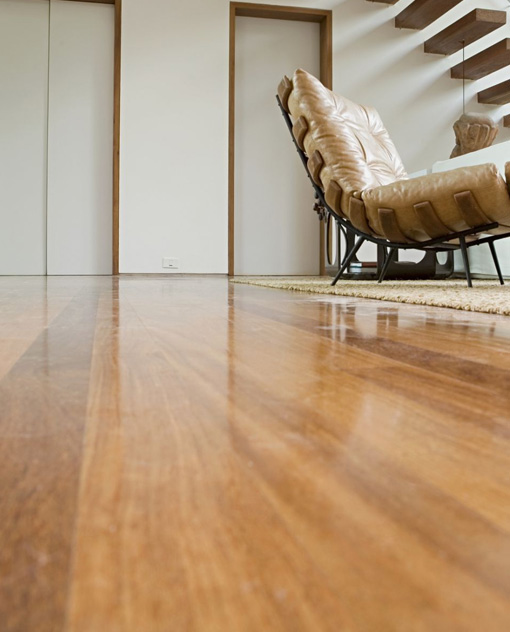SOLID AND ENGINEERING WOOD FLOORS
ENGINEERED FLOORING
Engineered wood flooring is a real wood floor covering which consists of 3 or more layers and each layer is placed in a manner wherein the grain runs at 90 degree – this construction dramatically enhances its stability. There is minimal or no change in shape with changes in humidity. The top layer of an engineered board (the lamella) is solid wood, usually hardwood, of 3mm thickness. The lamella is securely bonded to two further support layers of New Zealand Pine. Engineered Wood Flooring is available in contemporary colours with beautiful brushed texture. Its unique Supermatt UV Polyurethane Nano Finish gives it the look of high-class finish without sacrificing wear durability. Engineered wood flooring are made in one of the most advance factories and only woods that are from sustainable forests are being used in the production of engineered wood flooring.
Engineering wood is mainly used for sound absoption due to the nature of consturction. The middle and bottom layer is made of durable plywood, which helps is absorption of sound in studios, theatres, conference halls and specialized area.
SOLID WOOD FLOORING
Solid wood flooring brings the natural outdoors inside and is ideal for those who want the warmth and beauty of a real wood floor. As it is a natural product every hardwood floor installed will be individual and different from the next.
BAMBOO FLOORING
Bamboo flooring is extremely strong, long-lasting and just plain gorgeous to look at. It's also one of the most environmentally friendly building materials on the market today.
Bamboo flooring makers use one of the hardiest species of bamboo, cut it into strips before drying and laminating it under pressure. The result is a flooring product that's stronger than maple or red oak.
Bamboo flooring is installed just like hardwood tongue-and-groove flooring, either glued together or nailed down.
Bamboo flooring typically comes in 3-foot or 6-foot lengths and with or without the distinctive bamboo 'nodes' visible in the grain. Pre-finished bamboo flooring is usually coated with aluminide oxide lamination (urethane). Bamboo flooring comes in two colour variations - a natural blonde or carbonized during the drying process. Other various shades too are availbale in Bamboo floors from the wild bamboo range specially developed by UNITED floors.
Because it is a natural, renewable resource, bamboo flooring is considered by many experts and homeowners to be the logical flooring choice of the future. As Bamboo has a positive energy emission, health experts and Fengu shai experts advice bqmboo as an apt flooring for homes and offices for health and prosperity.
Bamboo is technically a grass, not a wood product, and it can be harvested every 5 years. As a result, no forests are destroyed to make bamboo floors, and homeowners can count on a reliable supply of products at stable prices for the foreseeable future.
The bamboo boards come in tongue-and-groove planks 72 or 36 inches long that are installed the same way as hardwood flooring. Floating or long-strip bamboo boards are made of several smaller pieces joined together to make a much longer and wider plank, which reduces installation time.
ALL ABOUT ENGINEERING / SOLID WOOD / BAMBOO FLOORING INSTALLATION & FLOOR CARE
Installation is with tongue-and-groove planking that can be nailed, stapled or glued down. Warranties will usually cover the finish and the structure for at least several years.
These floorings should be acclimatized in the room in which it will be installed for 2 to 3 days. These flooring can be nailed or stapled over a sub-floor of wood, plywood or oriented strand board. When installing over a sub-floor, you will need to ensure a proper moisture balance for the sub-floor and the bamboo. Manufacturer's instructions include information on this proper balance and how to attain it. If you choose to install your bamboo flooring with adhesive, you may want to consider bringing in a professional installer. Only 100% urethane-based adhesive should be used, and water-based adhesive should never be used.
Maintaining your new Engineering / Solid Wood / Bamboo Flooring floor is as easy as looking after other contemporary flooring finishes. Keep free of dirt and dust, use a broom, dry mop or a soft brush attachment on your vacuum cleaner. When cleaning, avoid excessive water - use a slightly dampened mop, and never use abrasive cleaners or scouring pads like steel wool on your bamboo. Any non-abrasive hardwood cleaner is suitable for your bamboo floors. Always use door mats. All natural and resilient floors will be subject to seasonal contraction and expansion and the day-to-day toll of furniture, appliances and normal residential activity, and these flooring is no different. You can protect your floor from indentations and scratches by using furniture leg pads and avoiding wearing spike-heeled shoes.


